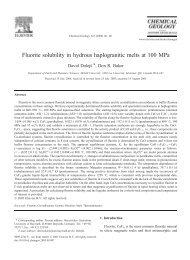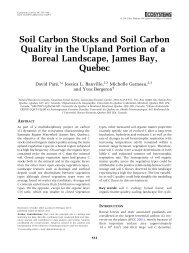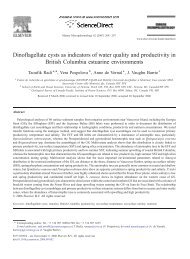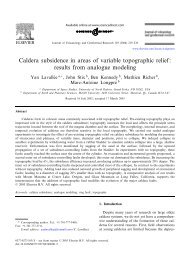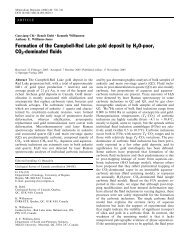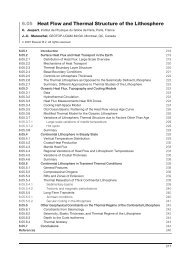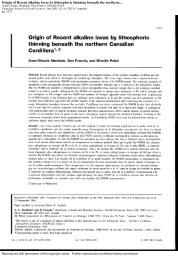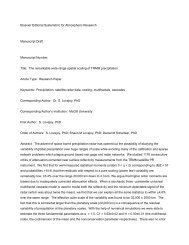Sediment sources of northern QuEbec and Labrador glacial ...
Sediment sources of northern QuEbec and Labrador glacial ...
Sediment sources of northern QuEbec and Labrador glacial ...
Create successful ePaper yourself
Turn your PDF publications into a flip-book with our unique Google optimized e-Paper software.
Quaternary Science Reviews 28 (2009) 3236–3245<br />
Contents lists available at ScienceDirect<br />
Quaternary Science Reviews<br />
journal homepage: www.elsevier.com/locate/quascirev<br />
<strong>Sediment</strong> <strong>sources</strong> <strong>of</strong> <strong>northern</strong> Québec <strong>and</strong> <strong>Labrador</strong> <strong>glacial</strong> deposits <strong>and</strong> the<br />
northeastern sector <strong>of</strong> the Laurentide Ice Sheet during ice-rafting events<br />
<strong>of</strong> the last <strong>glacial</strong> cycle<br />
Martin Roy a, *, Sidney R. Hemming b , Michel Parent c<br />
a Département des Sciences de la Terre et de l’Atmosphère <strong>and</strong> GEOTOP Geochemistry <strong>and</strong> Geodynamics Research Center, Université du Québec à Montréal,<br />
Succ. Centre-Ville, C.P. 8888, Montréal, QC, Canada H3C 3P8<br />
b Lamont-Doherty Earth Observatory <strong>of</strong> Columbia University, Rt. 9W, Palisades, NY 10964, USA<br />
c Geological Survey <strong>of</strong> Canada, 490 de la Couronne St., Québec City, QC, Canada G1K 9A9<br />
article<br />
info<br />
abstract<br />
Article history:<br />
Received 2 December 2008<br />
Received in revised form<br />
10 August 2009<br />
Accepted 10 August 2009<br />
Provenance studies <strong>of</strong> anomalously high-flux layers <strong>of</strong> ice-rafted detritus (IRD) in North Atlantic sediments<br />
<strong>of</strong> the last <strong>glacial</strong> cycle show evidence for massive iceberg discharges coming from the Hudson<br />
Strait region <strong>of</strong> the Laurentide Ice Sheet (LIS). Although these so-called Heinrich events (H events) are<br />
commonly thought to be associated with abrupt drawdown <strong>of</strong> the LIS interior, uncertainties remain<br />
regarding the sector(s) <strong>of</strong> this multi-domed ice sheet that conveyed ice through Hudson Strait. In<br />
Northern Québec <strong>and</strong> <strong>Labrador</strong> (NQL), large-scale patterns <strong>of</strong> <strong>glacial</strong> lineations indicate massive ice flows<br />
towards Ungava Bay <strong>and</strong> Hudson Strait that could reflect the participation <strong>of</strong> the <strong>Labrador</strong>–Québec ice<br />
dome in H events. Here we evaluate this hypothesis by constraining the source <strong>of</strong> NQL <strong>glacial</strong> deposits,<br />
which provide an estimate <strong>of</strong> the provenance characteristics <strong>of</strong> IRD originating from this sector.<br />
Specifically, we use 40 Ar/ 39 Ar ages <strong>of</strong> detrital hornblende grains in 25 till samples distributed along<br />
a latitudinal transect (lat. 58 ) extending east <strong>and</strong> west <strong>of</strong> Ungava Bay. The data show that tills located<br />
west <strong>and</strong> southwest <strong>of</strong> the Ungava Bay region are largely dominated by hornblende grains with Archean<br />
ages (>2.6 Ga), while tills located east <strong>of</strong> Ungava Bay are characterized by grains with early Paleoproterozoic<br />
ages (2.0–1.8 Ga), although most samples contain a few Archean-age grains. IRD derived from<br />
the NQL region should thus be characterized by a large proportion <strong>of</strong> Archean-age detrital grains, which<br />
contrasts significantly with the predominant Paleoproterozoic 40 Ar/ 39 Ar ages (1.8–1.6 Ga) typically<br />
reported for the dominant age population <strong>of</strong> hornblende grains in H layers. Comparisons with IRD<br />
through the last <strong>glacial</strong> cycle from a western North Atlantic core <strong>of</strong>f Newfoundl<strong>and</strong> do not show evidence<br />
for any prominent ice-rafted event with the provenance characteristics <strong>of</strong> NQL <strong>glacial</strong> deposits, thereby<br />
suggesting that significant ice-calving event(s) from the <strong>Labrador</strong>–Québec sector may have been limited<br />
throughout that interval. Although these results tend to point towards a relative stability <strong>of</strong> this ice dome<br />
during H events, our study also indicates that further provenance work is required on IRD proximal to the<br />
Hudson Strait mouth in order to constrain with a greater confidence the sector(s) <strong>of</strong> the LIS that fed ice<br />
into Hudson Strait during H events. Alternatively, these results <strong>and</strong> other paleogeographic considerations<br />
tend to support models suggesting that part <strong>of</strong> the Ungava Bay <strong>glacial</strong> lineations could be associated with<br />
a Late-Glacial ice flow across Hudson Strait.<br />
Ó 2009 Elsevier Ltd. All rights reserved.<br />
1. Introduction<br />
The greater Hudson Strait region was subject to important icedynamic<br />
events during the last <strong>glacial</strong> cycle, notably in the form <strong>of</strong><br />
* Corresponding author. Tel.: þ1 514 987 3000; fax: þ1 514 987 7749.<br />
E-mail addresses: roy.martin@uqam.ca (M. Roy), sidney@ldeo.columbia.edu<br />
(S.R. Hemming), miparent@nrcan.gc.ca (M. Parent).<br />
large drainage episodes <strong>of</strong> <strong>glacial</strong> ice through Hudson Strait (e.g.<br />
Andrews, 1998), with concomitant massive iceberg discharges in the<br />
North Atlantic ocean that have had a strong impact on climate (Bond<br />
et al., 1992; Broecker et al., 1992). These so-called Heinrich events (H<br />
events) are also significant in terms <strong>of</strong> ice sheet dynamics because<br />
the composition <strong>and</strong> sedimentological characteristics <strong>of</strong> the associated<br />
ice-rafted detritus (IRD) imply sudden <strong>and</strong> episodic collapses <strong>of</strong><br />
the Laurentide Ice Sheet (LIS) (Andrews <strong>and</strong> Tedesco, 1992; Dowdeswell<br />
et al.,1995; Gwiazda et al.,1996; Hemming et al.,1998, 2000;<br />
0277-3791/$ – see front matter Ó 2009 Elsevier Ltd. All rights reserved.<br />
doi:10.1016/j.quascirev.2009.08.008
M. Roy et al. / Quaternary Science Reviews 28 (2009) 3236–3245 3237<br />
see also Hemming, 2004 for a review). Other North Atlantic ice<br />
sheets appear to have released icebergs in approximate synchroneity<br />
(Grousset et al.,1993, 2000, 2001; Bond <strong>and</strong> Lotti,1995; Scourse et al.,<br />
2000; Knutz et al., 2001, 2002, 2007; 2003; Jullien et al., 2006; Peck<br />
et al., 2006, 2007), but their contribution to IRD concentrations was<br />
small with respect to the LIS. Although multiple mechanisms have<br />
been suggested to explain the cause/origin <strong>of</strong> H events (e.g.<br />
Hemming, 2004), most glaciological <strong>and</strong> paleoclimatic proxy-based<br />
models put forward to explain these large iceberg discharges involve<br />
drawdown <strong>of</strong> large amount <strong>of</strong> ice from the central part <strong>of</strong> the LIS<br />
(MacAyeal, 1993; Alley <strong>and</strong> MacAyeal, 1994; Alley et al., 2005;<br />
Marshall <strong>and</strong> Koutnik, 2006). The spatial distribution <strong>of</strong> <strong>glacial</strong><br />
lineations <strong>and</strong> patterns <strong>of</strong> post-<strong>glacial</strong> rebound (e.g. Peltier, 2002;<br />
Tarasov <strong>and</strong> Peltier, 2004), however, indicate that Hudson Bay was<br />
not the area with the thickest ice, but was rather surrounded by three<br />
important ice domes that fed the margins as well as the interior <strong>of</strong><br />
the LIS (Fig. 1a)(Dyke <strong>and</strong> Prest, 1987). Extensive mapping <strong>of</strong> <strong>glacial</strong><br />
striations on multifaceted rock outcrops <strong>and</strong> boulder tracing <strong>of</strong><br />
lithological indicators <strong>of</strong> <strong>glacial</strong> transport indicate large-scale<br />
displacements <strong>of</strong> these ice domes during the last <strong>glacial</strong> cycle (Parent<br />
et al., 1995; Veillette et al., 1999; Clark et al., 2000; Jansson et al.,<br />
2002; McMartin <strong>and</strong> Henderson, 2004; Veillette, 2004). These<br />
reorganizations <strong>of</strong> the ice divide system likely reflect important icesurface<br />
changes <strong>of</strong> the LIS, which could be related to the postulated<br />
ice sheet collapses during Heinrich events (Clark et al., 2000; Dyke<br />
et al., 2002).<br />
Additionally, the occurrence <strong>of</strong> major ice-flow patterns that<br />
converge towards Hudson Bay <strong>and</strong> Hudson Strait could also reflect<br />
disintegration paths associated with Heinrich-type drawdown<br />
episodes <strong>of</strong> the LIS. This is well illustrated in Northern Québec <strong>and</strong><br />
<strong>Labrador</strong> (NQL) where the numerous fields <strong>of</strong> <strong>glacial</strong> lineations that<br />
characterize the Ungava Bay region (Fig. 1b) were linked to a major<br />
ice-draining event (or several synchronous events) <strong>of</strong> the northeastern<br />
sector <strong>of</strong> the LIS that may have contributed to the massive<br />
iceberg discharges associated with H events (Jansson et al., 2003).<br />
The contribution <strong>of</strong> the <strong>Labrador</strong>–Québec ice dome to H events<br />
during the Last Glacial cycle <strong>and</strong> the significance <strong>of</strong> the NQL <strong>glacial</strong><br />
flutings in such events, however, remain largely unconstrained.<br />
Overall, little is known on the sector(s) <strong>of</strong> the LIS <strong>and</strong> associated iceflow<br />
paths that conveyed ice to the Hudson Bay/Strait region during<br />
H events, <strong>and</strong> this represents an important limitation in our<br />
underst<strong>and</strong>ing <strong>of</strong> the LIS in the context <strong>of</strong> H events.<br />
Here we document the provenance <strong>of</strong> NQL <strong>glacial</strong> sediments<br />
(tills) representing the sediment source carried by Ungava Bay ice<br />
streams <strong>and</strong> other regional ice-flow trajectories, which ultimately<br />
delivered ice <strong>and</strong> associated IRD to the ocean. For this purpose, we<br />
use the single-step laser fusion 40 Ar/ 39 Ar method to date 241<br />
detrital hornblende grains from 25 samples roughly located on the<br />
A<br />
B<br />
Fig. 1. A) Schematic configuration <strong>of</strong> the Laurentide ice sheet around the last <strong>glacial</strong> maximum (after Dyke <strong>and</strong> Prest, 1987; Dyke et al., 2002). Thin <strong>and</strong> discontinuous lines represent<br />
<strong>glacial</strong> flow-lines coming from three main ice-dispersal centers located around Hudson Bay. Glacial flow-lines are based on the trend <strong>of</strong> <strong>glacial</strong> lineations that were mapped from<br />
drumlins <strong>and</strong> <strong>glacial</strong>ly molded outcrops from aerial photographs <strong>and</strong> field observations. Continuous lines within the ice sheet mark the approximate extent <strong>of</strong> each sector. V23–14<br />
indicates the name <strong>and</strong> location <strong>of</strong> the marine core used in this study. The letters A <strong>and</strong> G designate the Appalachians <strong>and</strong> the Gulf <strong>of</strong> St-Lawrence regions, respectively. B) Details <strong>of</strong><br />
<strong>glacial</strong> lineations in the study area (modified from Prest et al., 1968; Clark et al., 2000). The extent <strong>of</strong> the post-<strong>glacial</strong> marine limit is shown by a light gray zone around the coasts.<br />
Location <strong>of</strong> till samples is marked by dark gray squares.
3238<br />
M. Roy et al. / Quaternary Science Reviews 28 (2009) 3236–3245<br />
58th parallel <strong>and</strong> covering three main regions west, southwest, <strong>and</strong><br />
east <strong>of</strong> Ungava Bay (Figs. 1b <strong>and</strong> 2). We compare the results to<br />
published 40 Ar/ 39 Ar ages obtained from H layers <strong>and</strong> other minor<br />
IRD in a western North Atlantic core located east <strong>of</strong> Newfoundl<strong>and</strong><br />
(Fig. 1a) (Hemming <strong>and</strong> Hajdas, 2003) to evaluate whether the<br />
provenance signature <strong>of</strong> NQL <strong>glacial</strong> deposits can be recognized in<br />
marine sediments <strong>of</strong> the last <strong>glacial</strong> cycle.<br />
2. What sector <strong>of</strong> the LIS contributed to the ice discharges?<br />
The identification <strong>of</strong> the LIS as the main source for the massive<br />
iceberg discharges associated with H events comes primarily from<br />
provenance work on anomalously high-flux layers <strong>of</strong> IRD in North<br />
Atlantic deep-sea sediments <strong>of</strong> the last <strong>glacial</strong> cycle, which were<br />
first recognized by the high concentrations <strong>of</strong> lithic grains in the<br />
coarse fraction <strong>of</strong> IRD (Heinrich, 1988). The high detrital carbonate<br />
concentration that characterizes the terrigenous sediment fraction<br />
<strong>of</strong> H layers was attributed to a calving ice margin that overrode<br />
a carbonate-floored substrate, likely corresponding to the one that<br />
covers large areas <strong>of</strong> Hudson Bay <strong>and</strong> Hudson Strait (Andrews <strong>and</strong><br />
Tedesco, 1992; Bond et al., 1992; Broecker et al., 1992). The LIS origin<br />
for H event was also reinforced by radiogenic provenance studies.<br />
Lead <strong>and</strong> neodymium isotope systematics measured on bulk sediment<br />
suggested an Archean heritage <strong>of</strong> the terrigenous fraction <strong>of</strong> H<br />
layers, while Pb isotopes <strong>of</strong> feldspar grains <strong>and</strong> 40 Ar/ 39 Ar ages <strong>of</strong><br />
hornblende grains indicated Paleoproterozoic metamorphism<br />
(w1.8 Ga) <strong>of</strong> the source-rocks <strong>of</strong> H layers (Gwiazda et al., 1996;<br />
Hemming et al., 1998, 2000; Hemming, 2004). These characteristics<br />
further confined the source region <strong>of</strong> H layers to the rocks <strong>of</strong> the<br />
Paleoproterozoic Churchill Province <strong>of</strong> the Canadian Shield, which<br />
outcrop in the Hudson Strait area (Fig. 3). These results, along with<br />
other sedimentological data, led to the interpretation that a large<br />
fraction <strong>of</strong> the LIS in Hudson Bay drained repeatedly through an ice<br />
stream flowing in Hudson Strait (e.g. Andrews, 1998).<br />
Although the LIS was unequivocally the main contributor <strong>of</strong><br />
detrital material to H layers, the exact sector <strong>of</strong> the LIS that<br />
conveyed ice through Hudson Strait has yet to be identified. Hudson<br />
Bay is commonly regarded as the source <strong>of</strong> the drawdown <strong>of</strong><br />
large amount <strong>of</strong> ice, mostly because this region is underlain by<br />
Paleozoic carbonates. Unlike the coarse-grained crystalline rocks <strong>of</strong><br />
the Shield, this substrate provides s<strong>of</strong>t-bedded conditions that are<br />
necessary to generate the fast-flowing ice that has been invoked to<br />
accommodate the massive iceberg discharges, in addition to<br />
provide a source for the high detrital carbonate content <strong>of</strong> most H<br />
layers (Andrews <strong>and</strong> Tedesco, 1992; Marshall <strong>and</strong> Clarke, 1997).<br />
However, field-based paleogeographic reconstructions <strong>and</strong><br />
patterns <strong>of</strong> post-<strong>glacial</strong> uplift indicate that Hudson Bay was a site <strong>of</strong><br />
lower ice-surface elevation where ice flows were converging from<br />
the three nearby centers <strong>of</strong> outflow (Dyke <strong>and</strong> Prest, 1987; Dyke,<br />
2004; Tarasov <strong>and</strong> Peltier, 2004) (Fig. 1a). The difficulty in identifying<br />
the sector <strong>of</strong> the LIS that fed the Hudson Strait ice stream on<br />
the basis <strong>of</strong> sedimentary <strong>and</strong> radiogenic data from ocean cores also<br />
comes from the occurrence at the mouth <strong>of</strong> Hudson Strait <strong>of</strong><br />
a bedrock sill, which is composed <strong>of</strong> Paleoproterozoic crystalline<br />
rocks <strong>of</strong> the Churchill Province (Fig. 3). Because this sill rises w300–<br />
400 m above the seafloor, it likely acted as an important grounding<br />
line for this ice stream (Andrews <strong>and</strong> MacLean, 2003; Hulbe et al.,<br />
2004; Alley et al., 2005). The occurrence <strong>of</strong> a significant overdeepened<br />
zone located up-ice from the sill further suggests that it<br />
may have been an area <strong>of</strong> important sub<strong>glacial</strong> erosion during the<br />
calving/streaming episodes that led to H events (Hemming, 2004).<br />
Consequently, part <strong>of</strong> the geochemical signature <strong>of</strong> H layers likely<br />
contain erosional products <strong>of</strong> this bedrock protuberance, thereby<br />
complicating the identification <strong>of</strong> ice flow coming from the LIS<br />
interior on the basis <strong>of</strong> IRD data alone. This points to the need <strong>of</strong><br />
Fig. 2. Location <strong>of</strong> till samples investigated in this study (red squares) with respect to the main ice-flow patterns in Northern Quebec <strong>and</strong> <strong>Labrador</strong>, shown here as flow-sets. Iceflow<br />
sets were defined by Clark et al. (2000) on the basis <strong>of</strong> detailed mapping <strong>of</strong> <strong>glacial</strong> lineations. Ice-flow set fsJ03 comes from Jansson et al. (2003). These ice-flow patterns are<br />
here used to identify the main trajectories along which detrital material can be transported to the ocean, regardless <strong>of</strong> the age <strong>of</strong> formation <strong>of</strong> these features. Black arrows show<br />
postulated ice flows within <strong>and</strong> around the Hudson Strait <strong>and</strong> Ungava Bay regions based from field evidence <strong>and</strong> inferred by glaciological modeling. Light gray areas around the<br />
coasts <strong>and</strong> main river valleys show the approximate extent <strong>of</strong> the post-<strong>glacial</strong> marine invasion. For interpretation <strong>of</strong> the references to colour in this figure legend, the reader is<br />
referred to the web version <strong>of</strong> this article.
M. Roy et al. / Quaternary Science Reviews 28 (2009) 3236–3245 3239<br />
Fig. 3. Bedrock geology map showing the main lithology mantling the floor <strong>of</strong> Hudson Strait <strong>and</strong> Ungava Bay (modified from Andrews <strong>and</strong> MacLean, 2003). Inset shows the location<br />
<strong>of</strong> the Abloviak sill, which is composed <strong>of</strong> Paleoproterozoic crystalline basement rocks that raise w350 m above the Hudson Strait floor (MacLean, 2001).<br />
better documenting the provenance <strong>of</strong> <strong>glacial</strong> deposits that are<br />
associated with massive ice-flow paths extending from the<br />
different ice domes into the Hudson Bay <strong>and</strong> Hudson Strait region<br />
in order to further constrain the source <strong>of</strong> LIS ice for H events.<br />
Nonetheless, in addition to large-scale patterns <strong>of</strong> <strong>glacial</strong> lineations<br />
that indicate massive ice flows towards Hudson Bay/Strait<br />
(e.g. Clark et al., 2000; Jansson et al., 2003), Heinrich-type drawdown<br />
episodes are suggested by the occurrence <strong>of</strong> sequences <strong>of</strong><br />
shifting ice flows documented from rock outcrops all around<br />
Hudson Bay (Parent et al., 1995; Veillette et al., 1999; McMartin <strong>and</strong><br />
Henderson, 2004; Veillette, 2004), mostly because these reorganizations<br />
<strong>of</strong> ice sheet pr<strong>of</strong>ile require significant ice-surface<br />
lowering <strong>of</strong> certain sectors <strong>of</strong> the LIS. These erosive <strong>and</strong> geomorphic<br />
features, however, have yet to be documented within the context <strong>of</strong><br />
H events.<br />
3. NQL <strong>glacial</strong> lineations <strong>and</strong> the northeastern sector <strong>of</strong> the<br />
Laurentide Ice Sheet<br />
The NQL region comprises a large fraction <strong>of</strong> the area formerly<br />
occupied by the <strong>Labrador</strong>–Quebec ice dome, which was the main<br />
center <strong>of</strong> ice outflow <strong>of</strong> the northeastern sector <strong>of</strong> the LIS (Fig.1). The<br />
l<strong>and</strong>scape <strong>of</strong> this region is characterized by abundant drumlins,<br />
crag-<strong>and</strong>-tails, <strong>glacial</strong>ly molded bedrock outcrops, <strong>and</strong> fluted till<br />
plains with disseminated areas <strong>of</strong> crystalline rock outcrops (Fig. 4)<br />
(Hughes, 1964; Prest et al., 1968; Lauriol, 1982; Gray <strong>and</strong> Lauriol,<br />
1985; Bouchard <strong>and</strong> Marcotte, 1986; Gray et al., 1993; Parent et al.,<br />
1995; Clark et al., 2000; Gray, 2001; Jansson et al., 2003). These<br />
<strong>glacial</strong> lineations are associated with former <strong>glacial</strong> flow-lines that<br />
were coming from this ice dome, presumably sometime after the<br />
last <strong>glacial</strong> maximum (LGM) (Fig. 1). This region encompasses<br />
Ungava Bay where the long axis <strong>of</strong> most <strong>glacial</strong> lineations shows an<br />
impressive pattern <strong>of</strong> converging ice flows towards Ungava Bay<br />
(Fig. 2)(Clark et al., 2000; Jansson et al., 2002). Detailed examination<br />
<strong>of</strong> aerial photographs <strong>and</strong> satellite images showed that the Ungava<br />
Bay <strong>glacial</strong> lineations can be grouped into discrete networks <strong>of</strong> iceflow<br />
sets (Clark et al., 2000; Jansson et al., 2003). These swarms <strong>of</strong><br />
<strong>glacial</strong> lineations were attributed to fast-flowing ice <strong>and</strong> interpreted<br />
to reflect imprints <strong>of</strong> former ice streams. On the basis <strong>of</strong> crosscutting<br />
relationships, as evidenced by abrupt lateral margins <strong>of</strong> the<br />
different ice-flow fans <strong>and</strong> other geomorphological features, a relative<br />
chronology describing a sequence <strong>of</strong> ice stream development<br />
was further proposed. In this model, these l<strong>and</strong>form systems would<br />
have formed over a relatively broad time-interval spanning part <strong>of</strong><br />
the last <strong>glacial</strong> cycle (Jansson et al., 2003). There are, however,<br />
almost no chronological constraints for these events. This lack <strong>of</strong><br />
constraints is at the origin <strong>of</strong> considerable contrasting interpretations<br />
regarding the age <strong>of</strong> these <strong>glacial</strong> lineations (e.g. Clark et al.,<br />
2000; Jansson et al., 2002), ranging from relict l<strong>and</strong>forms from an<br />
older deglaciation preserved under cold-based ice during the last<br />
<strong>glacial</strong> cycle (Kleman et al., 1994), to Late-Glacial features <strong>of</strong> the last<br />
glaciation (Veillette et al., 1999; Dyke et al., 2002).<br />
Of importance here is that the ice-dynamic conditions imposed<br />
by the large-scale ice-flow patterns formed by the Ungava Bay <strong>glacial</strong><br />
lineations led to the suggestion that these Ungava Bay ice-flow<br />
systems were likely the results <strong>of</strong> a major ice-flow event(s) that<br />
drained the <strong>Labrador</strong>–Québec ice dome interior during H events,<br />
supposedly through <strong>glacial</strong> flow-lines feeding the Hudson Strait ice<br />
stream (Jansson et al., 2003). This link between the <strong>Labrador</strong>–Québec<br />
sector <strong>and</strong> drawdown episodes <strong>of</strong> the LIS can also be seen in various<br />
geological models <strong>and</strong> paleogeographic reconstructions on H events,<br />
mainly in the form <strong>of</strong> a branch <strong>of</strong> the Hudson Strait ice stream (Fig. 2)<br />
(Andrews, 1998; Andrews <strong>and</strong> MacLean, 2003; Hulbe et al., 2004).<br />
Although involving the <strong>Labrador</strong>–Québec ice dome in Heinrich-type<br />
events appears to be a logical mechanism to drain large amount <strong>of</strong> ice<br />
from the deep interior <strong>of</strong> the ice sheet, there is little direct evidence<br />
to support such a model. Involving the northeastern sector <strong>of</strong> the LIS<br />
in the ice discharges <strong>of</strong> H events through Ungava Bay also requires<br />
important constraints to be met, notably an ice-free Hudson Strait<br />
(i.e. an ice stream retracted west <strong>of</strong> Ungava Bay), or, alternatively, the<br />
presence <strong>of</strong> a Hudson Strait ice stream that has ice thickness/velocity<br />
characteristics that allows ice from the Ungava ice stream network to<br />
feed this main ice outlet (e.g. Kirby <strong>and</strong> Andrews,1999; Andrews <strong>and</strong><br />
MacLean, 2003).<br />
4. Approach <strong>and</strong> methods<br />
Twenty-five till samples were collected along an east–west<br />
transect roughly centered on latitude 58 North (Figs. 1 <strong>and</strong> 2). This<br />
transect is broken into three sectors due to the presence <strong>of</strong> extensive<br />
marine deposits that mask the underlying <strong>glacial</strong> deposits in<br />
low-lying areas around the coasts <strong>of</strong> Ungava Bay <strong>and</strong> eastern<br />
Hudson Bay (Figs. 1b <strong>and</strong> 2). The surficial till samples used in this<br />
study were collected above the post-<strong>glacial</strong> marine limit to avoid
3240<br />
M. Roy et al. / Quaternary Science Reviews 28 (2009) 3236–3245<br />
Fig. 4. Aerial photograph (A) <strong>and</strong> oblique photograph (B) showing the <strong>glacial</strong> l<strong>and</strong>scape <strong>of</strong> the study area, which is characterized by drumlin fields, fluted till plains, crag-<strong>and</strong>-tails,<br />
molded bedrock outcrops, <strong>and</strong> disseminated outcrops <strong>of</strong> bare crystalline bedrock. Aerial photographs no. R6076-L-55, from National Airphoto Library, 1:60,000 scale. Photograph<br />
taken nearby Lac Peters, west <strong>of</strong> Ungava Bay, 71 00 0 W, 59 30 0 N; drumlins axis w065 N.<br />
any possible reworking <strong>of</strong> the <strong>glacial</strong> deposits. The samples come<br />
from <strong>glacial</strong>ly fluted till plain composed <strong>of</strong> a relatively thin mantle<br />
(2–3 m) <strong>of</strong> <strong>glacial</strong> deposits that is broken in places by rock outcrops<br />
(Fig. 4). Till in this area is characterized by a coarse (s<strong>and</strong>y) matrix<br />
containing abundant clasts, reflecting the erosion <strong>of</strong> local crystalline<br />
lithologies (Parent et al., 2004).<br />
Figs. 1 <strong>and</strong> 2 show the position <strong>of</strong> the three sectors <strong>of</strong> till<br />
samples with respect to the main <strong>glacial</strong> flow-lines in this region.<br />
These flow-lines are largely based on the geomorphologic <strong>and</strong><br />
striation records, for which chronological constraints are <strong>of</strong>ten<br />
lacking. Although some <strong>of</strong> these flow-lines may be asynchronous,<br />
<strong>and</strong> thus schematic, they provide important information on the<br />
possible trajectories along which ice may have flowed from the ice<br />
dome to the ocean. Within the context <strong>of</strong> the main ice-flow paths<br />
in the NQL region (Clark et al., 2000; Jansson et al., 2003), the till<br />
samples are expected to characterize the catchment areas <strong>of</strong> the<br />
<strong>glacial</strong> debris entrained by ice flowing toward north-northeast <strong>and</strong><br />
northwest into Ungava Bay westard into northeastern Hudson Bay,<br />
<strong>and</strong> to the eastward (into the <strong>Labrador</strong> Sea (Fig. 2). Although there<br />
are no till samples located directly south <strong>of</strong> Ungava Bay in the area<br />
comprising ice-flow sets extending northward into the bay, the<br />
regional ice-flow patterns (Clark et al., 2000; Jansson et al., 2003)<br />
indicate that the till samples <strong>of</strong> the middle sector lie on the<br />
western edge <strong>of</strong> such former ice-flow paths (Fig. 2). The patterns <strong>of</strong><br />
regional ice flows also indicate that the till <strong>of</strong> the middle sector,<br />
like the till south <strong>of</strong> Ungava Bay, orginates from ice taking its<br />
source in the interior <strong>of</strong> <strong>Labrador</strong>–Quebec ice dome. Because <strong>of</strong><br />
their nature (till genesis), the composition <strong>of</strong> these deposits should<br />
represent a mixture <strong>of</strong> the lithologies that were progressively<br />
incorporated during <strong>glacial</strong> transport, <strong>and</strong> their provenance characteristics<br />
should thus reflect the general bedrock composition <strong>of</strong><br />
this region. The main geological divisions show that tills southwest<br />
<strong>and</strong> south <strong>of</strong> Ungava Bay derive largely from the erosion <strong>of</strong> the<br />
same source-rock, i.e. the Superior Province (Fig. 5). Consequently,<br />
whether the middle sector till samples are associated with<br />
erosion/deposition <strong>of</strong> a northeastward flowing ice (as suggested by<br />
the dominant ice-flow pattern) or by northward-flowing ice (as<br />
suggested by regional ice-flow patterns), the geological setting <strong>of</strong><br />
this area indicates that these tills should integrate the same<br />
source-rock. Accordingly, the provenance characteristics <strong>of</strong> the<br />
middle sector till samples can be considered representative <strong>of</strong><br />
sediments that would be carried by ice flowing northward into<br />
Ungava Bay.<br />
Individual hornblende grains <strong>of</strong> 125–250 mm in size were<br />
extracted from the fine-grained matrix <strong>of</strong> till samples using<br />
a binocular microscope. Hornblende grains were irradiated for ten<br />
hours in the Cd-lined, in-core facility (CLICIT) <strong>of</strong> the TRIGA reactor at<br />
Oregon State University, along with hornblende-monitor st<strong>and</strong>ard<br />
Mmhb (age <strong>of</strong> 525 Ma; Samson <strong>and</strong> Alex<strong>and</strong>er, 1987) <strong>and</strong> a sanidine<br />
st<strong>and</strong>ard (Cima, 18.9 Ma, relative to MMhb-1 age <strong>of</strong> 523.2 2.3 Ma;<br />
Spell <strong>and</strong> McDougall, 2003). Approximately 10 detrital hornblende<br />
grains were dated in each sample using the 40 Ar/ 39 Ar method<br />
through single-step laser fusion at Lamont–Doherty Earth Observatory<br />
(LDEO), for a total <strong>of</strong> 241 age-determinations. Ages were<br />
calculated from Ar isotope ratios corrected for mass fractionation,<br />
interfering nuclear reactions, procedural blanks, <strong>and</strong> atmospheric Ar<br />
contamination.<br />
The 40 Ar/ 39 Ar ages <strong>of</strong> detrital hornblendes are first evaluated<br />
within the context <strong>of</strong> the numerical ages reported for the potential<br />
rock-source areas (i.e. the main geological provinces found in the<br />
region, described in the next section). The 40 Ar/ 39 Ar ages <strong>of</strong> hornblende<br />
correspond to either an estimate <strong>of</strong> igneous crystallization,<br />
or, alternatively, the last time the source terrane was subjected to<br />
high-temperature metamorphism (i.e. >450 C) (McDougall <strong>and</strong><br />
Harrison, 1999). Given the numerous orogens that characterize the<br />
geological history <strong>of</strong> this part <strong>of</strong> the Canadian Shield, the 40 Ar/ 39 Ar<br />
ages <strong>of</strong> hornblende grains from NQL tills should primarily reflect<br />
the last time the source terranes were involved in a major metamorphic<br />
event. These 40 Ar/ 39 Ar ages provide information on the<br />
provenance <strong>of</strong> the <strong>glacial</strong> sediments entrained by ice, <strong>and</strong> thus the<br />
geochemical signature <strong>of</strong> ice-rafted material that would be associated<br />
with iceberg discharges coming from the NQL region.<br />
The 40 Ar/ 39 Ar ages <strong>of</strong> hornblende grains <strong>of</strong> tills are also<br />
compared to 40 Ar/ 39 Ar ages <strong>of</strong> IRD grains from H layers <strong>and</strong> minor<br />
IRD layers <strong>of</strong> marine sediments spanning the time-interval<br />
comprised between the early Holocene <strong>and</strong> 43 ka (Hemming <strong>and</strong><br />
Hajdas, 2003).<br />
5. Geological setting <strong>of</strong> the Ungava Bay region<br />
With the exception <strong>of</strong> the Paleozoic carbonate rocks covering<br />
the floor <strong>of</strong> Hudson Strait <strong>and</strong> part <strong>of</strong> Ungava Bay, the rocks<br />
underlying the study area are almost entirely composed <strong>of</strong><br />
Precambrian basement rocks <strong>of</strong> the Canadian Shield, which in the<br />
Ungava Bay region, includes three structural provinces that were<br />
assembled during various orogens: the Superior, Churchill, <strong>and</strong>
M. Roy et al. / Quaternary Science Reviews 28 (2009) 3236–3245 3241<br />
Fig. 5. Simplified bedrock geology <strong>of</strong> the Hudson Strait <strong>and</strong> Ungava Bay regions (based on the Geological Survey map 1860A by Wheeler et al., 1996).<br />
Nain provinces (Fig. 5) (H<strong>of</strong>fman, 1989). The rocks forming these<br />
provinces, <strong>and</strong> thus rock-source regions for this study, can be<br />
distinguished according to their dominant radiometric imprint,<br />
which generally reflects the last major orogenic (metamorphic)<br />
event to affect the province (i.e. age <strong>of</strong> thermotectonic resetting).<br />
Specifically, the region west <strong>of</strong> Ungava Bay is composed <strong>of</strong><br />
Archean gneiss <strong>and</strong> other high-grade metamorphic rocks <strong>of</strong> the<br />
Superior Province (Minto sub-province). Hornblende grains<br />
derived from the <strong>glacial</strong> erosion <strong>of</strong> these rocks should thus be<br />
characterized by 40 Ar/ 39 Ar ages <strong>of</strong> w >2.6 Ga (Card, 1990). The<br />
<strong>northern</strong> tip <strong>of</strong> the Ungava Peninsula consists primarily in Paleoproterozoic<br />
(2.5–1.6 Ga) volcanic-arc terranes <strong>of</strong> the Cape Smith<br />
thrust belt that were accreted during the New-Quebec orogen<br />
(St-Onge et al., 1999). This orogen is also responsible for the<br />
formation <strong>of</strong> the <strong>Labrador</strong> Trough that extends southward from<br />
Ungava Bay, along a b<strong>and</strong> <strong>of</strong> a few hundred kilometers wide. The<br />
rocks east <strong>and</strong> southeast <strong>of</strong> Ungava Bay also belong to the eastern<br />
Churchill (Rae) Province (Lewry <strong>and</strong> Stauffer, 1990) <strong>and</strong> although<br />
they have an Archean heritage, they are primarily characterized by<br />
a strong Paleoproterozoic imprint inherited from major episodes<br />
<strong>of</strong> high-temperature metamorphism (Lewry <strong>and</strong> Stauffer, 1990),<br />
notably during the Torngat Orogen that produced the prominent<br />
Torngat mountain range that separates Ungava Bay from the <strong>Labrador</strong><br />
Sea. In this area, the Nain Province shows up as a series <strong>of</strong><br />
Mesoproterozoic (1.6–0.9 Ga) intrusions that cover a large area<br />
extending from the <strong>Labrador</strong> coast to the southernmost extent <strong>of</strong><br />
the <strong>Labrador</strong> Trough. Consequently, 40 Ar/ 39 Ar ages <strong>of</strong> the hornblende<br />
grains originating from the erosion <strong>of</strong> the Churchill (Rae)<br />
rocks should cluster around 1.9–1.7 Ga, while tills derived from ice<br />
advances having overridden the Nain sector should have<br />
hornblende grains yielding 40 Ar/ 39 Ar ages <strong>of</strong> w1.6–1.4 Ga. Metasedimentary<br />
rocks <strong>of</strong> the Churchill Province also crop out at the<br />
eastern end <strong>of</strong> Hudson Strait, within the Abloviak shear zone that<br />
extents from the Torngat Mountains in a NW–SE trend, parallel to<br />
the main regional structural boundaries (MacLean, 2001).<br />
6. Results<br />
The results <strong>of</strong> 40 Ar/ 39 Ar dating <strong>of</strong> individual hornblende grains<br />
from tills are shown as individual probability plots in Fig. 6 where<br />
data are grouped into 5 sectors according to the position <strong>of</strong> the<br />
major ice-flow trajectories defined by the patterns <strong>of</strong> <strong>glacial</strong> flowlines<br />
in the region (Bouchard <strong>and</strong> Marcotte, 1986; Clark et al., 2000;<br />
Jansson et al., 2003). Till samples from the eastern, west-central, <strong>and</strong><br />
western sectors should represent the characteristics <strong>of</strong> sediments<br />
transported by ice converging into Ungava Bay (Fig. 2). Tills <strong>of</strong> the<br />
westernmost sector represent sediment source from ice draining into<br />
northeastern Hudson Bay, while tills from the easternmost sector<br />
characterize material draining directly into the <strong>Labrador</strong> Sea (Fig. 2).<br />
Tills from the westernmost <strong>and</strong> western sectors show detrital<br />
hornblende grains with Archean ages, with 40 Ar/ 39 Ar ages ranging<br />
predominantly from 2.60 to 2.75 Ga (Fig. 6), thus in agreement with<br />
age <strong>of</strong> the source-rock from this region – the Superior Province. Tills<br />
from the eastern <strong>and</strong> easternmost sectors are largely dominated by<br />
40 Ar/ 39 Ar ages ranging from 1.95 to 1.60 Ga (Fig. 6), reflecting the<br />
erosion <strong>of</strong> the underlying Paleoproterozoic bedrock <strong>of</strong> the Churchill<br />
<strong>and</strong> Nain provinces present in this area. A few grains with Archean<br />
ages are also found in tills adjacent to the eastern Ungava Bay<br />
coastline. This could reflect ice advance across the bay, from western<br />
Ungava Bay, as suggested by erosional marks that indicate the<br />
occurrence <strong>of</strong> such ice flow in this region (Paradis <strong>and</strong> Parent, 2002).<br />
Alternatively, the occurrence <strong>of</strong> sparse Archean-age grains may also<br />
reflect ice flow coming from the south. The ice-flow patterns in the<br />
Ungava Bay region (Clark et al., 2000; Jansson et al., 2003). show that<br />
some <strong>of</strong> the northward-flowing fans appear to take their source<br />
deep enough into the <strong>Labrador</strong>–Quebec sector to reach rocks <strong>of</strong> the<br />
Superior Province (Figs. 2 <strong>and</strong> 5). Tills from the west-central sector<br />
show a large population <strong>of</strong> hornblende grains with Archean ages, as<br />
well as abundant Paleoproterozoic-age grains (Fig. 6). This likely<br />
reflect the geographic position <strong>of</strong> these samples, which are located<br />
nearby the boundary between Archean <strong>and</strong> Paleoproterozoic
3242<br />
M. Roy et al. / Quaternary Science Reviews 28 (2009) 3236–3245<br />
A<br />
B<br />
Fig. 6. A) Normalized probability plot showing 40 Ar/ 39 Ar ages <strong>of</strong> hornblende grains dated in till samples <strong>of</strong> the study area. Colors correspond to the different sectors discussed in<br />
text. B) Stack histograms showing the distribution <strong>of</strong> 40 Ar/ 39 Ar ages <strong>of</strong> hornblendes for the 25 till samples <strong>of</strong> the different sectors. Note that Y axes are different in each histograms,<br />
while X axes are all identical, with 50-Myr bins. The number (n) <strong>of</strong> dated hornblende grains <strong>and</strong> associated samples in each sector are given at top <strong>of</strong> each histogram. The complete<br />
40 Ar/ 39 Ar data set <strong>and</strong> samples coordinates are presented in Table DR1, as supplementary material in the on-line appendix.
M. Roy et al. / Quaternary Science Reviews 28 (2009) 3236–3245 3243<br />
terranes (Fig. 5). The occurrence <strong>of</strong> Paleoproterozoic-age grains<br />
could also be attributed to ice-flow paths taking their source slightly<br />
to the east, on the Paleoproterozoic rocks <strong>of</strong> the <strong>Labrador</strong> Through,<br />
as indicated by the regional ice-flow patterns (Fig. 2).<br />
7. Discussion – conclusions<br />
<strong>Sediment</strong>ary <strong>and</strong> radiogenic provenance studies indicate that<br />
the detrital carbonate <strong>and</strong> crystalline rock fractions <strong>of</strong> IRD forming<br />
H layers derive from the Hudson Strait region (Hemming, 2004).<br />
Based on the age <strong>and</strong> geochemical composition <strong>of</strong> the IRD crystalline<br />
fraction, H layers show a clear link with the rocks forming<br />
the Hudson Strait sill, but the carbonate clast content <strong>of</strong> H layers<br />
implies a larger catchment area for which the extent is unconstrained.<br />
Ambient (non-Heinrich) IRD <strong>of</strong>f Hudson Strait does not<br />
include abundant carbonate clasts (e.g. Andrews <strong>and</strong> Tedesco,<br />
1992), thereby indicating that the ice discharges related to H events<br />
represent a different calving mechanism than those occurring<br />
between H events. Taken together, these results support models<br />
attributing the iceberg discharges <strong>of</strong> H events to an ice stream<br />
draining the LIS interior <strong>and</strong> calving at the mouth <strong>of</strong> Hudson Strait.<br />
How the LIS fed this ice stream is currently unknown, <strong>and</strong> an<br />
objective <strong>of</strong> this study was to examine whether the <strong>Labrador</strong>–<br />
Québec sector may have been a contributor. Large-scale patterns <strong>of</strong><br />
<strong>glacial</strong> lineations around Hudson Bay tend to agree with the<br />
postulated disintegration models <strong>of</strong> the LIS, whereby they indicate<br />
the convergence <strong>of</strong> massive ice flows from the three major icedispersal<br />
centers towards Hudson Bay/Strait (Dyke et al., 2002).<br />
Problems in identifying which <strong>of</strong> these ice domes fed the ice flow<br />
along the axis <strong>of</strong> Hudson Strait come from the fact that Churchillage<br />
rocks are found in the western <strong>and</strong> <strong>northern</strong> Hudson Bay<br />
regions, directly under or adjacent to the former position <strong>of</strong> these<br />
three major centers <strong>of</strong> ice outflow.<br />
Another difficulty comes from uncertainty in interpreting the<br />
significance <strong>of</strong> these major ice-flow patterns converging towards<br />
Hudson Bay <strong>and</strong> Hudson Strait. This complexity is well exemplified<br />
in the NQL region where multiple sets <strong>of</strong> <strong>glacial</strong> lineations indicating<br />
convergent ice flows towards Ungava Bay were interpreted<br />
to reflect a drainage-event(s) <strong>of</strong> the <strong>Labrador</strong>-Quebec ice dome<br />
interior during H events (Jansson et al., 2003). The data presented<br />
in this paper suggest that it may be possible to evaluate this<br />
hypothesis by constraining the rock-source <strong>of</strong> the <strong>glacial</strong> sediments<br />
from three sectors located west, southwest, <strong>and</strong> east from Ungava<br />
Bay, which should provide an estimate <strong>of</strong> the provenance characteristics<br />
<strong>of</strong> IRD deriving from ice exiting these sectors. Specifically,<br />
40 Ar/ 39 Ar ages <strong>of</strong> detrital hornblende grains from NQL <strong>glacial</strong><br />
sediments indicate that ice flow from the northeastern sector <strong>of</strong> the<br />
LIS through northeastern Hudson Bay <strong>and</strong> Ungava Bay should have<br />
incorporated debris characterized by a significant portion <strong>of</strong><br />
Archean-age detrital grains.<br />
Insights on the occurrence <strong>of</strong> ice-draining event(s) from the<br />
<strong>Labrador</strong>–Québec sector can be obtained from the provenance <strong>of</strong><br />
major (Heinrich) <strong>and</strong> minor (non-Heinrich) IRD deposits in North<br />
Atlantic sediment cores located downstream from Hudson Strait.<br />
The chronology <strong>of</strong> deep-sea record could further provide timing for<br />
this event(s). Hemming <strong>and</strong> Hajdas (2003) report an extensive<br />
record <strong>of</strong> near-continuous IRD <strong>sources</strong> in a core that spans the last<br />
43 ka, an interval encompassing Heinrich event 0 (H0) through H4<br />
(dated at w11, 14.5, 20.5, 27, 34 14 C ka, respectively). Because <strong>of</strong> its<br />
location <strong>of</strong>f Newfoundl<strong>and</strong>, in the western part <strong>of</strong> the Ruddiman<br />
IRD belt, this core (V23–14) provides a record <strong>of</strong> LIS iceberg<br />
contributions coming from the Gulf <strong>of</strong> St-Lawrence as well as the<br />
<strong>Labrador</strong> Sea, thus including the Hudson Strait region (Fig. 1). The<br />
40 Ar/ 39 Ar ages <strong>of</strong> hornblende grains reported show a predominance<br />
<strong>of</strong> Paleoproterozoic-age IRD during <strong>and</strong> between H events from 43<br />
to 30 ka, <strong>and</strong> after 17 ka. The data also document the a real evolution<br />
<strong>of</strong> the LIS through time, with IRD contribution from the<br />
Grenville <strong>and</strong> Appalachians becoming more common from H3<br />
(w30 ka) to H1 (w17 ka), as the ice sheet gained in volume <strong>and</strong><br />
exp<strong>and</strong>ed over southern latitudes (Fig. 7). Does this record contain<br />
IRD with a strong Archean-age signature such as the one that would<br />
be expected for ice draining the NQL region?<br />
IRD layers with grains corresponding to source-rocks typical <strong>of</strong><br />
the Superior Province are present throughout this interval, but they<br />
form at most 5–10% <strong>of</strong> the population <strong>of</strong> grains dated. No significant<br />
ice-rafting event with a predominant Archean source-rock has<br />
been identified throughout this interval. However, the overall<br />
predominance <strong>of</strong> IRD derived from a Paleoproterozoic rock-source<br />
may also be related to the bedrock sill <strong>of</strong> this age at the mouth <strong>of</strong><br />
Hudson Strait, as discussed earlier. If this site was subject to<br />
important <strong>glacial</strong> erosion, this may have resulted in the production<br />
<strong>of</strong> a large volume <strong>of</strong> sediments, which may have diluted the signal<br />
<strong>of</strong> other rock-<strong>sources</strong> associated with ice flows coming from the ice<br />
sheet interior. On the other h<strong>and</strong>, the occurrence <strong>of</strong> a prominent<br />
dispersal train <strong>of</strong> distinctive <strong>glacial</strong> erratics (reddish rocks <strong>of</strong> the<br />
Dubawnt Group) coming from Keewatin <strong>and</strong> going across <strong>northern</strong><br />
Hudson Bay (Shilts, 1980) suggests that important amount <strong>of</strong><br />
detrital material can be transported into the Strait, <strong>and</strong> possibly<br />
into <strong>Labrador</strong> Sea. The presence <strong>of</strong> significant amount <strong>of</strong> carbonate<br />
grains in IRD also suggests that detrital material up stream from the<br />
sill can reach the ocean. The greater proximity <strong>of</strong> Ungava Bay to the<br />
Fig. 7. Scatter plot <strong>of</strong> 40 Ar/ 39 Ar ages <strong>of</strong> detrital hornblende grains sampled from major<br />
<strong>and</strong> minor IRD in core V23–14 in the northwest Atlantic ocean (43.4 N, 45.25 W,<br />
3177 m; data from Hemming <strong>and</strong> Hajdas, 2003). The horizontal zones labeled H1–H4<br />
indicate the position <strong>of</strong> the Heinrich layers; the vertical lines on each side <strong>of</strong> the C <strong>and</strong><br />
S letters delineate the age-range associated with the Churchill <strong>and</strong> Superior provinces,<br />
respectively.
3244<br />
M. Roy et al. / Quaternary Science Reviews 28 (2009) 3236–3245<br />
Hudson Strait outlet thus tends to suggest that a drawdown from<br />
this sector can potentially be reflected in the marine IRD record.<br />
These issues clearly indicate that quantifying the amount <strong>of</strong> detrital<br />
sediments produced at the mouth <strong>of</strong> Hudson Strait sill <strong>and</strong> differentiating<br />
these sediments from other rock-<strong>sources</strong> in North Atlantic<br />
IRD represents an important challenge that should be the focus <strong>of</strong><br />
future studies. Although our results tend to preclude the occurrence<br />
<strong>of</strong> a major draining-event from the <strong>Labrador</strong>-Québec sector,<br />
we believe that a detailed study involving large volume <strong>of</strong> IRD in<br />
the <strong>Labrador</strong> Sea near the Hudson Strait is needed to provide<br />
a more rigorous test <strong>of</strong> the contribution <strong>of</strong> NQL in H events, even<br />
though the Archean-age fraction may end up to be diluted by<br />
erosional processes at the mouth <strong>of</strong> Hudson Strait.<br />
These results also leave open the question <strong>of</strong> when the Ungava<br />
Bay <strong>glacial</strong> lineations were formed, <strong>and</strong> where was the outlet <strong>of</strong> the<br />
ice involved? Direct interaction between the <strong>Labrador</strong>–Quebec<br />
sector <strong>and</strong> the <strong>Labrador</strong> Sea through Ungava Bay is intimately<br />
linked with the dynamics <strong>and</strong> position <strong>of</strong> the Hudson Strait ice<br />
stream. Although interpretation <strong>of</strong> airphotos <strong>and</strong> satellite images<br />
have led to the suggestion that parts <strong>of</strong> the Ungava Bay l<strong>and</strong>form<br />
swarm may have been formed over different time-intervals spanning<br />
part <strong>of</strong> the last glaciation (Clark et al., 2000; Jansson et al.,<br />
2003), extensive field measurements <strong>of</strong> ice-flow erosional features<br />
in NQL suggest that a large fraction <strong>of</strong> the Ungava Bay <strong>glacial</strong><br />
lineations were formed in Late-Glacial time, through the inl<strong>and</strong><br />
propagation <strong>of</strong> a northward ice flow that was initially confined into<br />
the Ungava Bay basin, <strong>and</strong> that eventually altered the radial outflow<br />
<strong>of</strong> the <strong>Labrador</strong>–Québec ice dome (Veillette et al., 1999). This<br />
capture event was attributed to the Gold Cove ice advance, which<br />
crossed Hudson Strait from Ungava Bay <strong>and</strong> reached the southern<br />
tip <strong>of</strong> Baffin Isl<strong>and</strong> at w10 14 Cka BP (Miller <strong>and</strong> Kaufman, 1990;<br />
Kaufman et al., 1993). If this scenario is correct, the northward<br />
trending Ungava Bay <strong>glacial</strong> lineations could be associated with an<br />
ice advance that took place either before or after H0 (wYounger<br />
Dryas), during a period when the Hudson Strait ice stream had<br />
retreated westward, away from the mouth <strong>of</strong> the Strait (Andrews,<br />
1998; Kirby <strong>and</strong> Andrews, 1999; Clark et al., 2000; Dyke et al., 2002;<br />
Andrews <strong>and</strong> MacLean, 2003). Another alternative would be that<br />
the Ungava Bay <strong>glacial</strong> lineations were formed during H3, late in<br />
Middle Wisconsinan time, because the provenance characteristics<br />
<strong>of</strong> H3 layers differ significantly from the other H layers. This<br />
suggests that through flow <strong>of</strong> ice along the eastern axis <strong>of</strong> Hudson<br />
Strait was probably absent at that time, <strong>and</strong> this setting would then<br />
allow across-the-strait flow from Ungava Bay. However, the relative<br />
chronology deduced from the striation record does not appear to<br />
support this hypothesis (e.g. Veillette et al., 1999).<br />
In summary, the comparison <strong>of</strong> provenance characteristics <strong>of</strong><br />
<strong>glacial</strong> deposits underlying distinct flow patterns <strong>of</strong> the NQL region<br />
<strong>and</strong> IRD <strong>of</strong> the North Atlantic marine record suggests that the<br />
<strong>Labrador</strong>–Québec sector contribution to calving event(s) into the<br />
North Atlantic appears to have been limited during the last <strong>glacial</strong><br />
cycle. Although these results suggest a relative stability <strong>of</strong> the<br />
<strong>Labrador</strong>–Québec ice dome during H events, this interpretation<br />
needs to be evaluated within the geological <strong>and</strong> geomorphological<br />
context <strong>of</strong> the Hudson Strait region.This study indicates indeed that<br />
further constraining the role <strong>of</strong> the Hudson Strait sill in the<br />
production <strong>of</strong> detrital sediments is critical to our underst<strong>and</strong>ing <strong>of</strong><br />
the exact sector <strong>of</strong> the LIS (<strong>and</strong> other North Atlantic ice sheets) that<br />
contributed to the marine IRD record throughout the last <strong>glacial</strong><br />
cycle. Similarly, the composition (radiogenic fingerprinting) <strong>of</strong><br />
<strong>glacial</strong> deposits associated with distinct flow patterns on l<strong>and</strong><br />
should be further investigated in order to better define ice<br />
sheet ocean interactions <strong>and</strong> the role <strong>of</strong> ice sheets in climate<br />
changes, as well as to bring additional information on the disintegration<br />
patterns <strong>of</strong> the LIS.<br />
Acknowledgements<br />
M. Charette contributed to sedimentological treatments <strong>of</strong><br />
samples <strong>and</strong> M. Laithier drafted some <strong>of</strong> the figures. An anonymous<br />
reviewer provided helpful <strong>and</strong> constructive comments on the<br />
manuscript. Funding for this project came from the LDEO Climate<br />
Center (MR <strong>and</strong> SRH), NSERC (MR), NOAA (SRH) <strong>and</strong> the GSC (MP).<br />
This is GEOTOP publication no. 2009-0019.<br />
Appendix. Supplementary information<br />
Supplementary data associated with this article can be found in<br />
the version at doi:10.1016/j.quascirev.2009.08.008<br />
References<br />
Alley, R.B., MacAyeal, D.R., 1994. Ice-rafted debris associated with binge/purge<br />
oscillations <strong>of</strong> the Laurentide Ice Sheet. Paleoceanography 9, 503–511.<br />
Alley, R.B., Andrews, J.T., Barber, D.C., Clark, P.U., 2005. Comment on ‘‘Catastrophic<br />
ice shelf breakup as the source <strong>of</strong> Heinrich event icebergs’’ by C.L. Hulbe et al.<br />
Paleoceanography 20, PA1009. 10.1029/2004PA001086.<br />
Andrews, J.T., 1998. Abrupt changes (Heinrich events) in Late Quaternary North<br />
Atlantic marine environments: a history <strong>and</strong> review <strong>of</strong> data <strong>and</strong> concepts.<br />
Journal <strong>of</strong> Quaternary Science 13, 3–16.<br />
Andrews, J.T., MacLean, B., 2003. Hudson Strait ice streams: a review <strong>of</strong> stratigraphy,<br />
chronology <strong>and</strong> links with North Atlantic Heinrich events. Boreas 32, 4–17.<br />
Andrews, J.T., Tedesco, K., 1992. Detrital carbonate-rich sediments, northwestern<br />
<strong>Labrador</strong> Sea: implications for ice sheet dynamics <strong>and</strong> iceberg rafting (Heinrich)<br />
events in the North Atlantic. Geology 20, 1087–1090.<br />
Bond, G., Heinrich, H., Broecker, W.S., Labeyrie, L., McManus, J., Andrews, J.T.,<br />
Huon, S., Jantschik, R., Clasen, S., Simet, C., Tedesco, K., Klas, M., Bonani, G.,<br />
Ivy, S., 1992. Evidence for massive discharges <strong>of</strong> icebergs into the North Atlantic<br />
ocean during the last <strong>glacial</strong> period. Nature 360, 245–249.<br />
Bond, G.C., Lotti, R., 1995. Iceberg discharges into the North Atlantic on millennial<br />
time scales during the last deglaciation. Science 267, 1005–1010.<br />
Bouchard, M.A., Marcotte, C., 1986. Regional <strong>glacial</strong> dispersal patterns in Ungava,<br />
Nouveau–Québec. Current Research, Part B. Geological Survey <strong>of</strong> Canada,<br />
295–304.<br />
Broecker, W.S., Bond, G.C., Klas, M.E., Clark, E., McManus, J.F., 1992. Origin <strong>of</strong><br />
<strong>northern</strong> Atlantic’s Heinrich events. Climate Dynamic 6, 265–273.<br />
Card, K.D., 1990. A review <strong>of</strong> the superior Province <strong>of</strong> the Canadian Shield, a product<br />
<strong>of</strong> Archean accretion. Precambrian Research 48, 99–156.<br />
Clark, C.D., Knight, J.A., Gray, G.T., 2000. Geomorphological reconstruction <strong>of</strong> the<br />
<strong>Labrador</strong> Sector <strong>of</strong> the Laurentide Ice Sheet. Quaternary Science Reviews 19,<br />
1343–1366.<br />
Dowdeswell, J.A., Maslin, M.A., Andrews, J.T., McCave, I.N., 1995. Iceberg production,<br />
debris rafting, <strong>and</strong> the extent <strong>and</strong> thickness <strong>of</strong> Heinrich layers H-1, H-2 in North<br />
Atlantic sediments. Geology 23, 301–304.<br />
Dyke, A.S., Prest, V.K., 1987. Paleogeography <strong>of</strong> <strong>northern</strong> North America,<br />
18,000–5,000 years ago. Geological Survey <strong>of</strong> Canada Map 1703A.<br />
Dyke, A.S., Andrews, J.T., Clark, P.U., Engl<strong>and</strong>, J.H., Miller, G.H., Shaw, J., Veillette, J.J.,<br />
2002. The Laurentide <strong>and</strong> Innuitian ice sheets during the last <strong>glacial</strong> maximum.<br />
Quaternary Science Reviews 21, 9–31.<br />
Dyke, A.S., 2004. An outline <strong>of</strong> North American deglaciation with emphasis on<br />
central <strong>and</strong> <strong>northern</strong> Canada. In: Ehlers, J., Gibbard, P.L. (Eds.), Quaternary<br />
Glaciations-Extent <strong>and</strong> Chronology Part II, vol. 2b. Elsevier, Amsterdam,<br />
pp. 373–424.<br />
Gray, J.T., Lauriol, B., 1985. Dynamics <strong>of</strong> the Late Wisconsin ice sheet in the Ungava<br />
Peninsula interpreted from geomorphological evidence. Arctic <strong>and</strong> Alpine<br />
Research 17, 289–310.<br />
Gray, J.T., Lauriol, B., Bruneau, D., Ricard, J., 1993. Post<strong>glacial</strong> émergence <strong>of</strong> Ungava<br />
Peninsula, <strong>and</strong> its relationship to <strong>glacial</strong> history. Canadian Journal <strong>of</strong> Earth<br />
Science 30, 1676–1696.<br />
Gray, J.T., 2001. Patterns <strong>of</strong> ice flow <strong>and</strong> deglaciation chronology for southern<br />
coastal margins <strong>of</strong> Hudson Strait <strong>and</strong> Ungava Bay. Geological Survey <strong>of</strong> Canada<br />
Bulletin 566, 31–55.<br />
Grousset, F.E., Labeyrie, L., Sinko, J.A., Cremer, M., Bond, G., Duprat, J., Cortijo, E.,<br />
Huon, S., 1993. Patterns <strong>of</strong> ice rafted detritus in the <strong>glacial</strong> North Atlantic<br />
(40–55 N). Paleoceanography 8, 175–192.<br />
Grousset, F.E., Pujol, C., Labeyrie, L., Auffret, G., Boelaert, A., 2000. Were the north<br />
Atlantic Heinrich events trigerred by the behavior <strong>of</strong> European ice sheets?<br />
Geology 28, 123–126.<br />
Grousset, F.E., Cortijo, E., Huon, S., Hervé, L., Richter, T., Burdl<strong>of</strong>f, D., Duprat, J.,<br />
Weber, O., 2001. Zooming in on Heinrich layers. Paleoceanography 16, 240–259.<br />
Gwiazda, R.H., Hemming, S.R., Broecker, W.S., Onsttot, T., Mueller, C., 1996. Evidence<br />
from 40 Ar/ 39 Ar ages for Churchill Province source <strong>of</strong> ice-rafted amphiboles in<br />
Heinrich layer 2. Journal <strong>of</strong> Glaciology 42, 440–446.<br />
Heinrich, H., 1988. Origin <strong>and</strong> consequences <strong>of</strong> cyclic ice rafting in the northeast<br />
Atlantic Ocean during the past 130,000 years. Quaternary Research 29, 142–152.
M. Roy et al. / Quaternary Science Reviews 28 (2009) 3236–3245 3245<br />
Hemming, S.R., 2004. Heinrich events: massive Late Pleistocene detritus layers <strong>of</strong><br />
the north Atlantic <strong>and</strong> their global climate imprint. Reviews <strong>of</strong> Geophysics 42,<br />
RG1005. 10.1029/2003RG000128.<br />
Hemming, S.R., Broecker, W.S., Sharp, W.D., Bond, G.C., Gwiazda, R.H., McManus, J.F.,<br />
Klas, M., Hajdas, I., 1998. Provenance <strong>of</strong> Heinrich layers in core V28–82,<br />
northeastern Atlantic: 40 Ar/ 39 Ar ages <strong>of</strong> ice-rafted hornblende, Pb isotopes in<br />
feldspar grains, <strong>and</strong> Nd–Sr–Pb isotopes in the fine sediment fraction. Earth <strong>and</strong><br />
Planetary Science Letters 164, 317–333.<br />
Hemming, S.R., Bond, G.C., Broecker, W.S., Sharp, W.D., Klas-Mendelson, M., 2000.<br />
Evidence from 40 Ar/ 39 Ar ages <strong>of</strong> individual hornblende grains for varying<br />
Laurentide <strong>sources</strong> <strong>of</strong> iceberg discharges 22,000 to 10,500 yr B.P. Quaternary<br />
Research 54, 372–383.<br />
Hemming, S.R., Hajdas, I., 2003. Ice-rafted detritus evidence from 40 Ar/ 39 Ar ages <strong>of</strong><br />
individual hornblende grains for evolution <strong>of</strong> the eastern margin <strong>of</strong> the Laurentide<br />
ice sheet since 43 14Cky. Quaternary International 99–100, 29–43.<br />
H<strong>of</strong>fman, P.H., 1989. Precambrian geology <strong>and</strong> tectonic history. In: Bally, A.W.,<br />
Palmer, A.R. (Eds.), The Geology <strong>of</strong> North America–an Overview. Geological<br />
Society <strong>of</strong> America, Decade North Am. Geol, vol. A, pp. 447–512.<br />
Hughes, O.L., 1964. Surficial geology, Nichicun–Kaniapiskau maparea, Quebec.<br />
Geological Survey <strong>of</strong> Canada Bulletin 106, 20.<br />
Hulbe, C.L., MacAyeal, D.R., Denton, G.H., Kleman, J., Lowell, T.V., 2004. Catastrophic<br />
ice shelf breakup as the source <strong>of</strong> Heinrich event icebergs. Paleoceanography<br />
19, PA1004. 10.1029/2003PA000890.<br />
Jansson, K.N., Kleman, J., Marchant, D.R., 2002. The succession <strong>of</strong> ice-flow patterns<br />
in north-central Québec–<strong>Labrador</strong>, Canada. Quaternary Science Reviews 21,<br />
503–523.<br />
Jansson, K.N., Stroeven, A.P., Kleman, J., 2003. Configuration <strong>and</strong> timing <strong>of</strong> Ungava<br />
Bay ice streams, <strong>Labrador</strong>–Ungava, Canada. Boreas 32, 256–262.<br />
Jullien, E., Grousset, F., Hemming, S.R., Peck, V.L., Hall, I.R., Jeantet, C., Billy, I., 2006.<br />
Contrasting conditions preceding MIS3 <strong>and</strong> MIS2 Heinrich events. Global <strong>and</strong><br />
Planetary Change 54, 225–238.<br />
Kaufman, D.S., Miller, G.H., Stravers, J.A., Andrews, J.T., 1993. Abrupt early Holocene<br />
(9.6–9.9 ka) ice-stream advance at the mouth <strong>of</strong> Hudson Strait, Arctic Canada.<br />
Geology 21, 1063–1066.<br />
Kirby, M.E., Andrews, J.T., 1999. Mid-Wisconsin Laurentide Ice Sheet growth <strong>and</strong><br />
decay: implications for Heinrich events-3 <strong>and</strong> -4. Paleoceanography 14, 211–223.<br />
Kleman, J., Borgström, I., Hättestr<strong>and</strong>, C., 1994. Evidence for a relict <strong>glacial</strong> l<strong>and</strong>scape<br />
in Québec–<strong>Labrador</strong>. Palaeogeography Palaeoclimatology Palaeoecology 111,<br />
217–228.<br />
Knutz, P.C., et al., 2002. Multidecadal ocean variability <strong>and</strong> the NW European ice<br />
sheet surges during the last deglaciation. Geochemistry Geophysics Geosystems<br />
3, 1077. 10.1029/2002GC000351.<br />
Knutz, P.C., Austin, W.E.N., Jones, E.J.W., 2001. Millennial-scale depositional cycles<br />
related to British ice sheet variability <strong>and</strong> North Atlantic paleocirculation since<br />
45 kyr B.P., Barra fan, U.K. margin. Paleoceanography 16, 53–64.<br />
Knutz, P.C., Zahn, R., Hall, I.R., 2007. Centennial-scale variability <strong>of</strong> the British Ice<br />
Sheet: Implications for climate forcing <strong>and</strong> Atlantic meridional overturning<br />
circulation during the last deglaciation. Paleoceanography 22, PA1207. 1029/<br />
2006PA001298.<br />
Lauriol, B.,1982. Geomorphologie quaternaire du sud de l’Ungava. Paleo-Quebec 15,174.<br />
Lewry, J.F., Stauffer, M.R., 1990. The early proterozoic trans-Hudson <strong>of</strong> America.<br />
Special Paper. Geological Association <strong>of</strong> Canada 37, 505.<br />
MacAyeal, D.R., 1993. Binge/purge oscilations <strong>of</strong> the Laurentide Ice Sheet as a cause<br />
<strong>of</strong> North Atlantic Heinrich events. Paleoceanography 8, 775–784.<br />
MacLean, B., 2001. Marine geology <strong>of</strong> Hudson Strait <strong>and</strong> Ungava Bay, Eastern<br />
Arctic Canada. In: MacLean, B. (Ed.), Late Quaternary <strong>Sediment</strong>s, Depositional<br />
Environments, <strong>and</strong> Late Glacial–De<strong>glacial</strong> History Derived from<br />
Marine <strong>and</strong> Terrestrial Studies. Geological Survey <strong>of</strong> Canada Bulletin, vol.<br />
566, p. 199.<br />
Marshall, S.J., Clarke, G.K.C., 1997. A continuum mixture model <strong>of</strong> ice stream thermomechanics<br />
in the Laurentide ice sheet: 2. Application to the Hudson Strait<br />
ice stream. Journal <strong>of</strong> Geophysical Research 102, 20615–20627.<br />
Marshall, S.J., Koutnik, M.R., 2006. Ice sheet action versus reaction: distinguishing<br />
between Heinrich events <strong>and</strong> Dansgaard-Oeschger cycles in the North Atlantic.<br />
Paleoceanography 21, PA2021. 10.1029/2005PA001247.<br />
Miller, G.H., Kaufman, D.S., 1990. Rapid fluctuations <strong>of</strong> the Laurentide Ice Sheet at<br />
the mouth <strong>of</strong> Hudson Strait: new evidence for ocean/ice-sheet interactions as<br />
a control on the younger dryas. Paleoceanography 5, 907–919.<br />
McDougall, I., Harrison, T.M., 1999. Geochronology <strong>and</strong> Thermochronology by the<br />
40 Ar/ 39 Ar Method. Oxford Univ. Press, New York, 269 pp.<br />
McMartin, I., Henderson, P.J., 2004. Evidence from Keewatin (central Nunavut) for<br />
paleo-ice divide migration. Géographie Physique et Quaternaire 58, 163–186.<br />
Parent, M., Paradis, S.J., Boisvert, E., 1995. Ice-flow patterns <strong>and</strong> <strong>glacial</strong> transport in<br />
the eastern Hudson Bay region: implications for the dynamics <strong>of</strong> the Laurentide<br />
Ice Sheet. Canadian Journal <strong>of</strong> Earth Sciences 32, 2057–2070.<br />
Paradis, S.J., Parent, M., 2002. Géologie des formations en surface, Rivière Koroc<br />
(moitié ouest), Québec–Terre-Neuve–et–<strong>Labrador</strong>. Geological Survey <strong>of</strong> Canada<br />
‘‘A’’ Series Map no. 2014A1.<br />
Parent, M., Beaumier, M., Girard, R., Paradis, S.J., 2004. Diamond exploration in the<br />
Archean craton <strong>of</strong> <strong>northern</strong> Québec – Kimberlite indicator minerals in eskers <strong>of</strong><br />
the Saindon–Cambrien corridor. Quebec Department <strong>of</strong> Natural Re<strong>sources</strong>,<br />
Report MB 2004–02, 15 p.<br />
Peck, V.L., Hall, I.R., Zahn, R., Elderfield, H., Grousset, F., Hemming, S.R., Scourse, J.D.,<br />
2006. High resolution evidence for linkages between NW European ice sheet<br />
instability <strong>and</strong> Atlantic Meridional Overturning Circulation. Earth <strong>and</strong> Planetary<br />
Science Letters 243, 476–488.<br />
Peck, V.L., Hall, I.R., Zahn, R., Grousset, F., Hemming, S.R., Scourse, J.D., 2007. The<br />
relationship <strong>of</strong> Heinrich events <strong>and</strong> their European precursors over the past<br />
60 ka BP: a multi-proxy ice-rafted debris provenance study in the North East<br />
Atlantic. Quaternary Science Reviews 26, 862–875.<br />
Peltier, W.R., 2002. Global <strong>glacial</strong> isostatic adjustment: paleogeodetic <strong>and</strong> space-geodetic<br />
tests <strong>of</strong> the ICE-4G (VM2) model. Journal <strong>of</strong> Quaternary Science 17, 491–510.<br />
Prest, V.K., Grant, D.R., Rampton, V.N., 1968. Glacial map <strong>of</strong> Canada. Geological<br />
Survey <strong>of</strong> Canada Map 1253A.<br />
Samson, S.D., Alex<strong>and</strong>er Jr., E.C., 1987. Calibration <strong>of</strong> the interlaboratory 40 Ar/ 39 Ar<br />
dating st<strong>and</strong>ard, MMhb-1. Chemical Geology 66, 27–34.<br />
Scourse, J.D., Hall, I.R., McCave, I.N., Young, J.R., Sugdon, C., 2000. The origin <strong>of</strong><br />
Heinrich layers: evidence from H2 for European precursor events. Earth <strong>and</strong><br />
Planetary Science Letters 182, 187–195.<br />
Shilts, W.W., 1980. Flow patterns in the central North American ice sheet. Nature<br />
286, 213–218.<br />
Spell, T.L., McDougall, I., 2003. Characterization <strong>and</strong> calibration <strong>of</strong> 40 Ar/ 39 Ar dating<br />
st<strong>and</strong>ards. Chemical Geology 198, 189–211.<br />
St-Onge, M.R., Lucas, S.B., Scott, D.L., Wodicka, N., 1999. Upper <strong>and</strong> lower plate juxtaposition,<br />
deformation, <strong>and</strong> metamorphism during crustal convergence, Trans-<br />
Hudson Orogen Quebec–Baffin segment, Canada. Precambrian Research 93, 27–49.<br />
Tarasov, L., Peltier, W.R., 2004. A geophysically constrained large ensemble analysis<br />
<strong>of</strong> the de<strong>glacial</strong> history <strong>of</strong> the North American ice-sheet complex. Quaternary<br />
Science Reviews 23, 359–388.<br />
Veillette, J.J., Dyke, A.S., Roy, M., 1999. Ice-flow evolution <strong>of</strong> the <strong>Labrador</strong> Sector <strong>of</strong><br />
the Laurentide Ice Sheet: a review, with new evidence from <strong>northern</strong> Quebec.<br />
Quaternary Science Reviews 18, 993–1019.<br />
Veillette, J.J., 2004. Ice-flow chronology <strong>and</strong> palimpsest, long-distance dispersal <strong>of</strong><br />
indicator clasts, north <strong>of</strong> the St. Lawrence River valley, Quebec. Geographie<br />
Physique et Quaternaire 58, 187–216.<br />
Wheeler, J.O., H<strong>of</strong>fman, P.F., Card, K.D., Davidson, A., Sanford, B.V., Okulitch, A.V.,<br />
Roest, W.R., 1996. Geological map <strong>of</strong> Canada. Geological Survey <strong>of</strong> Canada Map<br />
1860A.



